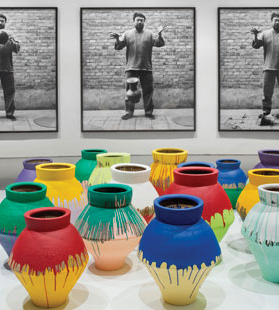
STUDY IN PERSPECTIVE Ai Weiwei’s art questions the hipocricy of China today
The spectacular exhibition covers a broad array of media, including audio, video, photography, sculpture and site-specific installations and deals with topics such as the questioning of traditional cultural values and political authority, social change and freedom. Ai Weiwei also incorporates his ongoing investigation of the aftermath of the Sichuan Earthquake in 2008 and his own experience with the suppression by the Chinese government into his more recent works.
The title of the exhibit pays tribute to a 1964 work by Jasper Johns — a patchwork of coded images and symbols. Many of Ai’s works are perhaps also best understood that way. A good example is the artist’s latest work, “He Xie,” or “river crabs,” which features thousands of ceramic river crabs piled together, creating a dramatic and impressive image. The message behind the work, however, needs deciphering. “River crab” is a homophone to “harmonious” in Chinese, both sharing the pinyin he xie. The Communist Party of China has always justified its suppression of human rights with the notion of “the realization of a harmonious society,” and in recent years, the Chinese netizens have used the term “river crabs” to represent the online sanctioning of the government. The work is thus a satirical statement against the Chinese government’s suppression of freedom of expression.
Ai Weiwei’s peculiar sense of humor also shines through in his other works. There are the photos of his outstretched middle finger in front of the White House and the Tiananmen Square, part of his collection “A Study in Perspective.” He also placed among the collection “Surveillance Camera” a marble sculpture of a surveillance camera, which references to the extensive monitoring and surveillance that Ai was himself placed under by the Chinese Communist Party.
There are sobering works among the collection, too. The entrance of the exhibition is marked by the heart-wrenching “Name List of Student Earthquake Victims Found by the Citizen Investigation” and “Remembrance,” a combination of audio and visual works. “Name List” is a wall-sized spreadsheet with the names, ages and schools of over 5,000 students who died in the Sichuan earthquake of 2008, when the region’s poorly constructed schools, known as “tofu-skin schools,” collapsed. “Remembrance” is an accompanying audio recording that recites the names of the children killed.
These works best demonstrate the convergence of Ai’s identities as artist and political activist, as they were the products of the independent investigation that he led after the earthquake after the government tried to conceal the actual number of students killed and the reasons behind the buildings’ collapse. It was the very project that put Ai on the top of the Communist Party’s blacklist.
The work that moved me the most, however, is “Straight.” Consisting of 38 tons of steel rebar recovered from the sites of collapsed schools in Sichuan, the work not only is a memorial of the tragedy but also carries a deeper message best expressed by the words of the artist himself, which are posted on the wall, “The tragic reality of today is reflected in the true plight of our spiritual existence: We are spineless and cannot stand straight.” The spirit of humanity and defiance resonates through Ai Weiwei’s works and actions, and for me, that is what makes him such a memorable figure.














